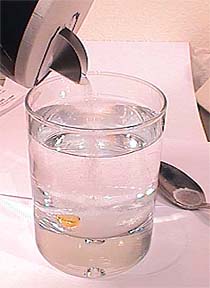


 Understanding Specific Gravity
Understanding Specific Gravity
Here's
one of my favorite demonstrations that is fun for everyone...and
good for gemologists and jewelers. Its a rather simple but graphic
demonstration of how the density of a medium will affect the weight
of another medium. Which is why a 1.00 carat sapphire is actually
smaller than a 1.00 carat diamond. Because a sapphire is more
dense than a diamond. Which means that a diamond and sapphire
of the same size will weigh differently.
To understand this demonstration we need to first see what it happening. Specific gravity of a material is based on its density. Density can be described in a number of ways. But for our purposes let's just call density as how much stuff is contained within a definite space. Such as a rectangle. Lets' assume that dots weight a factor or 1. If we take a rectangle of the same size and put a few dots in it, the rectangle will be a weight equal to the number of dots. Here is an example:

Now, let's assume that you have three gemstones of the same millimeter size. They are all 6mm in diameter. But when you weigh them on your carat scale they all weigh a different carat weight. The reason is the density of the gemstones. And since the density is different the specific gravity is different. Here is an example of three gemstones of different densities and therefore different specific gravities:

We can use this principle to determine the specific gravity of a gemstone by reversing the process. In other words, by using a liquid of a known density, we can drop the gemstone in and see how it reacts. Gemstones of a lesser density than a particular liquid will float, while gemstones of a greater density (specific gravity) will sink. Here is an example:

Now, lets see a specific example of how this works in gemology. First we will need some water, salt, and a piece of amber:
 Next we will drop the amber into the clear
water and see what happens:
Next we will drop the amber into the clear
water and see what happens:
 The amber sinks to the bottom. Now lets
start adding salt to the water.
The amber sinks to the bottom. Now lets
start adding salt to the water.

 The salt will make the water more dense.
Let's see what happens to the amber...
The salt will make the water more dense.
Let's see what happens to the amber...
 With a small amount of salt the amber
starts to become suspended....
With a small amount of salt the amber
starts to become suspended....
 The amber becomes suspended as the density
of the water equals the density of the amber
The amber becomes suspended as the density
of the water equals the density of the amber
 Eventually, the amber floats as the salt
causes the water to become more dense than the amber
Eventually, the amber floats as the salt
causes the water to become more dense than the amber
 And now the salt water is denser than
the amber and it floats.
And now the salt water is denser than
the amber and it floats.
What we have done is to raise the specific gravity of the water to a level above the specific gravity of the amber. Thereby causing the amber to float. We have not changed the density of the amber, but rather the density of the water in which it is placed. As the water becomes more dense the amber floats.
This is the concept behind testing gemstones for specific gravity. By placing them in liquids of known specific gravities or densities, we can ascertain the specific gravity of the gemstone by how it reacts within each liquid.
Question for your students: Can you guess why countries want their shipping ports to be in cities with salt water docks and not fresh water docks? First one to answer this question gets a free piece of Baltic amber with a bug in it.
Now you know why gemstones have different specific gravities, and why the SG test is important for gemstone identification. But you should always be careful with the SG liquids used to test gemstones. They are very caustic and dangerous, and should only be used with adult supervision.
Hope you enjoyed this demonstration. Please let me know if you did>
© YourGemologist.com 2002. I don't like having to put copyright marks on the photographs because it makes them hard to read. But please don't rip me off for these photographs. Simply ask permission to use them like everyone else.